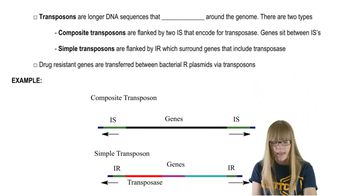Here are the essential concepts you must grasp in order to answer the question correctly.
Transposons
Transposons, or 'jumping genes,' are DNA sequences that can change their position within the genome. They can cause mutations by inserting themselves into or near genes, potentially disrupting normal gene function or regulatory elements. Understanding transposons is crucial for predicting the types of mutations they may induce during experiments, such as enhancer trapping.
Recommended video:
Prokaryotic Transposable Elements
Enhancer Elements
Enhancers are regulatory DNA sequences that can increase the likelihood of transcription of specific genes. They can be located far from the genes they regulate and interact with promoters to enhance gene expression. In the context of the question, the placement of enhancers adjacent to a transposon can lead to increased expression of the reporter gene, which is essential for understanding the mutagenesis outcomes.
Recommended video:
Mutagenesis
Mutagenesis refers to the process by which genetic information is changed, resulting in mutations. In the context of transposon experiments, mutagenesis can lead to various types of mutations, including insertions, deletions, or changes in gene expression. Recognizing the potential outcomes of mutagenesis is vital for predicting the effects of transposon insertions on adjacent genomic DNA.
Recommended video:
 Verified step by step guidance
Verified step by step guidance Verified video answer for a similar problem:
Verified video answer for a similar problem:

